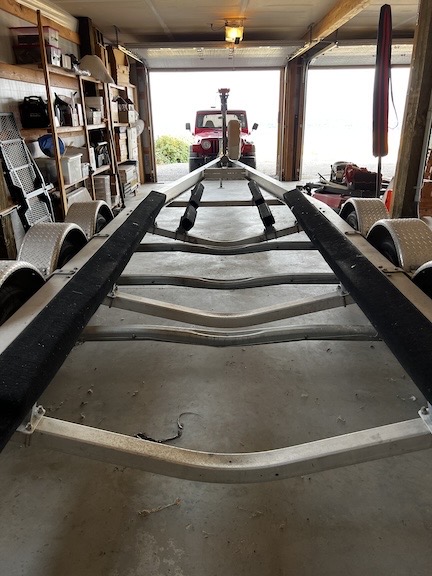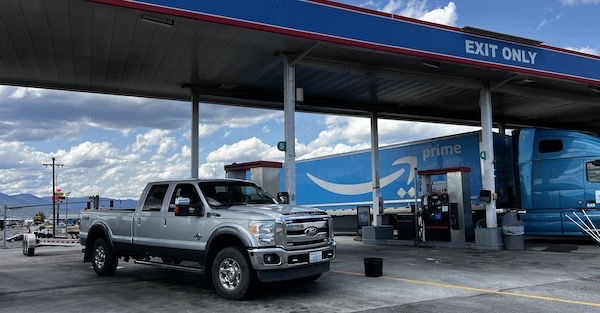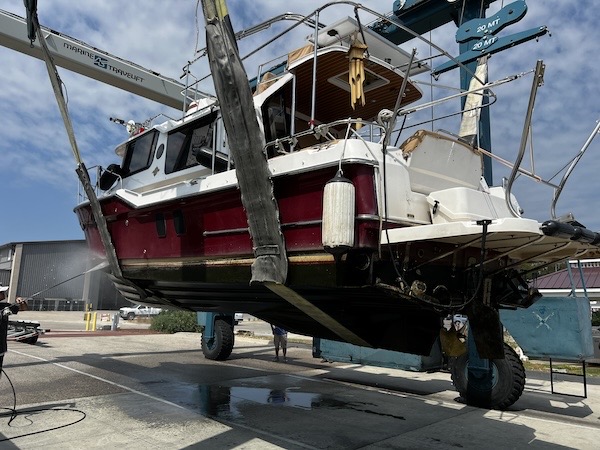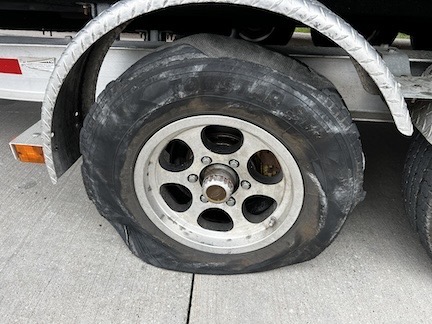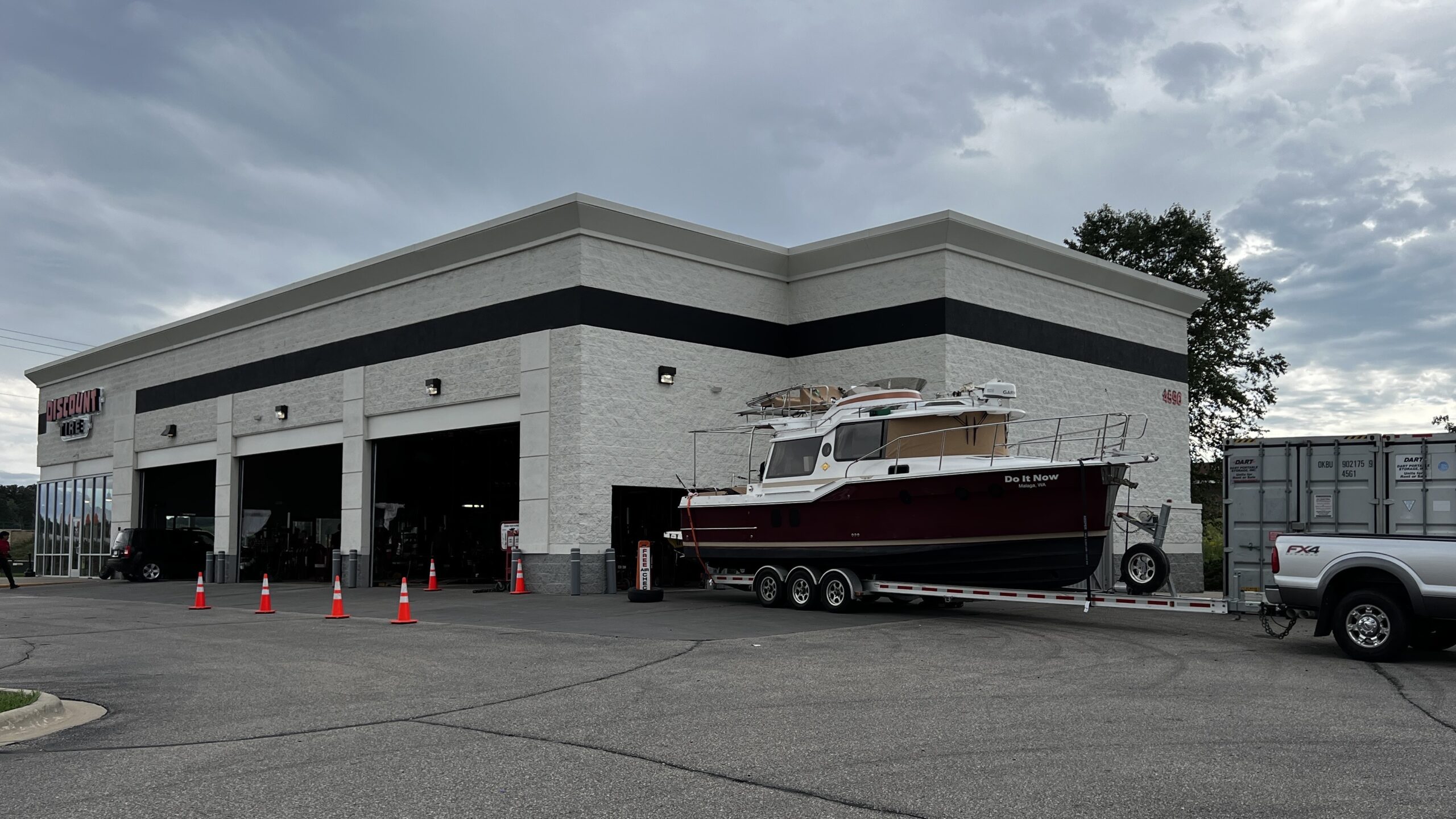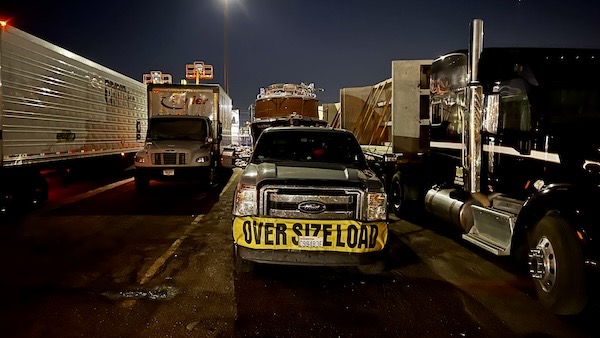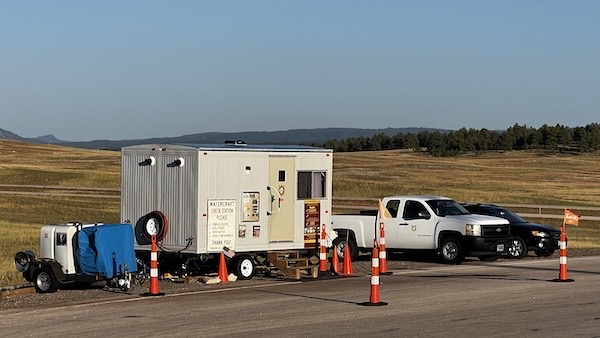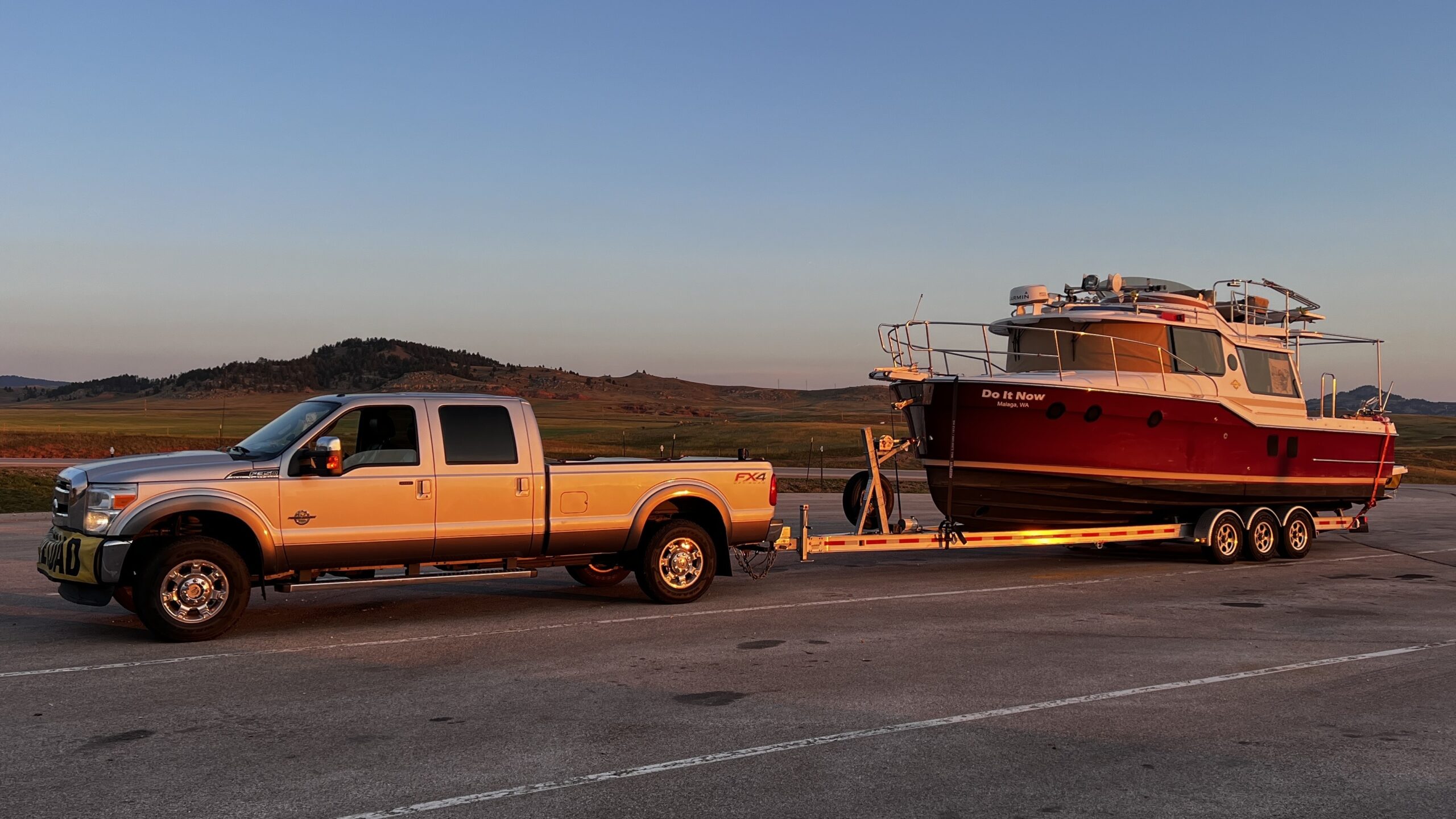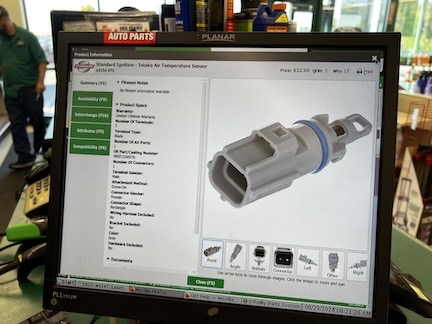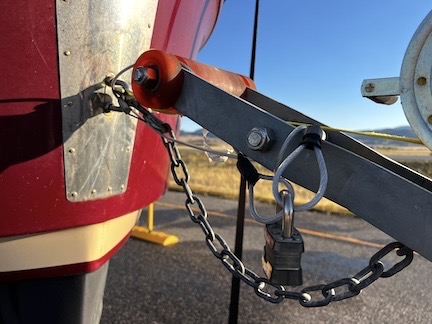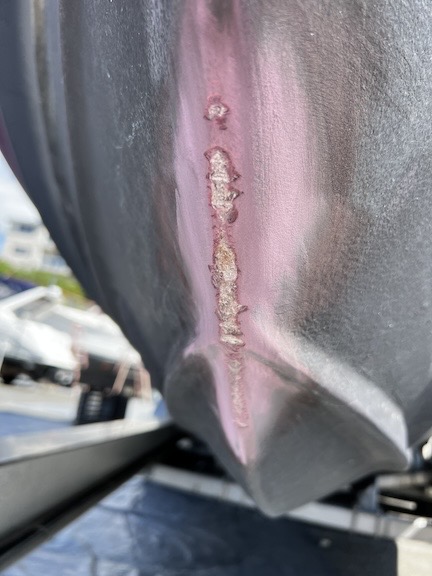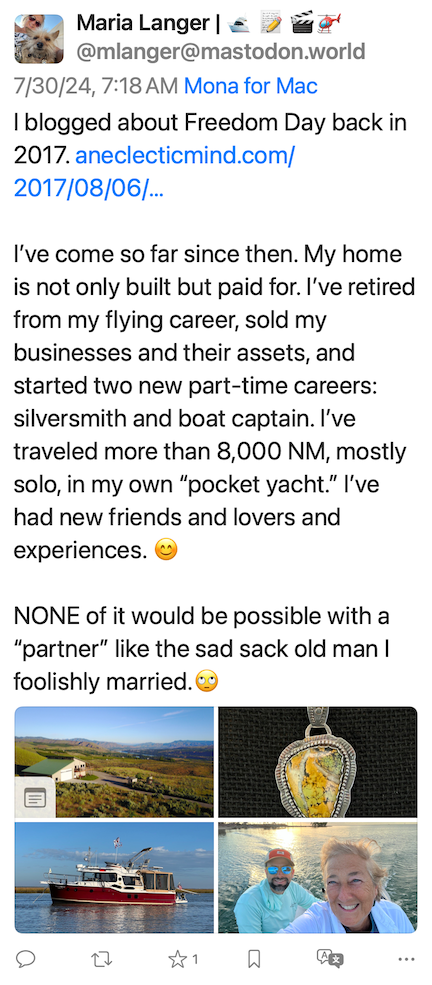The event that got me to drive 4200 miles with covid.
I’m not what you’d consider a very social person. I like spending time alone, doing things I enjoy doing.
But I do like to meet up with people who share common interests, especially if I can learn something from them. That’s what appeals most to me about the annual Ranger Tug/Cutwater Rendezvous hosted by Fluid Motion, LLC, maker of Ranger Tug, Cutwater, and Solara boats. By gathering together hundreds of Ranger Tug and Cutwater boat owners with their boats and providing manufacturer seminars and support opportunities, Fluid Motions has made it impossible to attend without learning something of value — meeting lots of great people along the way.
Best of all, this Rendezvous isn’t an obvious money grab by an organization in the business of cashing in on people’s desire for information. (Great Loop Cruisers might know an organization like that.) The cost is just $90/person and includes a nice bag of swag and lots of games, contests, and social events, with food and even alcoholic beverages. Fluid Motions isn’t making money on this event. It’s giving its customers an opportunity to gather, show off their boats, and learn.
Once I became a Ranger Tug owner, it made sense to attend the Rendezvous whenever possible. In fact, since it was so close to where I lived, it would be kind of dumb to miss it.
The Backstory
In early September 2022, I took delivery of my 2019 Ranger Tug R-29 CB, which I named Do It Now. My very first trip with it was a cruise to the Ranger Tug/Cutwater Rendezvous at Roche Harbor on San Juan Island. It was a long trip from Olympia to Roche Harbor and I did half of it solo. But I had an excellent time at the Rendezvous, where I met some great people and learned a ton.
In 2023, I was home for the summer — I hadn’t retired yet — and my boat was on the hard on Kent Island near Annapolis in Maryland. I still went to the Rendezvous. My work season was over and I’d decided to stay home until the end of September so I could blow out my irrigation lines before heading back to my boat. I took my Honda S2000 to Anacortes, drove it onto the ferry, and drove off at Friday Harbor. I stayed at a friend’s place on the island with my pups and drove to the Rendezvous every day. Most of my friends from the previous year were there and we had a good time. I participated more in social events and even did pretty well in the Scavenger Hunt.
Fast forward to 2024. From the very beginning of the year, when I was cruising in Florida, I knew I wanted to return to the Rendezvous with Do It Now. That desire basically set a deadline for my completion of the Great Loop: I needed to be done by mid-August to have enough time to haul the boat back to Washington State before the event, which is held at the end of Labor Day week. Heck, by that time I’d probably feel done with the Loop anyway. (Spoiler alert: I sure did.)
I should mention here that Roche Harbor is one of those marinas that gets everything right. They have a large, well-trained staff of dockhands to help boaters in. The cost of power and water is including in the dock price — I am so tired of paying extra for power! — and they even set up power extension cords to reach the boats at the end of the dock, like mine. The floating docks are in very good condition. There are garbage and recycling bins in multiple places right on the docks and they are never allowed to fill, let alone overflow. The restrooms are clean, although you do have to feed quarters into the showers. In-slip pumpout, courtesy of the Fecal Freak pumpout boat, is free. There are several restaurants and a very well stocked grocery store that handles everything from milk and fresh veggies to wine and fishing gear. (Amazingly, the prices are fair.) Their evening Colors ceremony, which plays music as each flag is lowered, is a heart-warming end to the day. Of course, the marina isn’t cheap, but I’ve paid a lot more for a lot less during my Great Loop travels.
Although I’d originally had the boat hauled out to Chicago with a boat transport company, I’d bought a boat trailer in late June 2023 and planned to haul it back myself. I was nervous about it — hauling a 14,000 pound wide load 2200 miles? But, if you’ve read my post about the the hoops I jumped through (with covid), you’ll know that it wasn’t quite as big an ordeal as I’d expected it to be. I got the boat back in time for the event.
I arrived at the Rendezvous just before sunset on Wednesday. I might have been the last boat in that day. I got a slip on the guest dock, which was packed three boats deep at most slips. I was immediately greeted by my neighbors, most of whom were having dinner. The event officially started in the morning, but Roche Harbor Resort and Marina was offering a deal where you’d pay for three nights and get the fourth for free. So just about everyone arrived on Wednesday.

I sent up my drone on Thursday morning, as soon as the docks were in full sun. Ranger Tugs and Cutwater boats filled the long guest dock in the foreground. The total boat count for the event was 220.
Day 1 of the Rendezvous
I attended the Volvo seminar, which had been so good the previous two years, on Thursday. It was terrible. For some reason, they had a marketing guy do a lot of the speaking and he focused in on the IPS systems that come with the Volvo engines on the R-43. The R-43 is a $1.2 million twin engine masterpiece that only 4 people in the audience owned. How do I know this? He asked us and four people raised hands. Yet 20+ minutes of his presentation talked about the amazing features of the Volvo system for these engines, leaving the rest of us wondering whether they’d ever get to anything of interest to us. The other mistake they made was taking questions about specific issues individuals were having with their engines. More time wasted on information that didn’t apply to most of us. By the time they did get around to general Volvo Penta D4 and D6 information, there wasn’t much time left. I was disappointed.

The Learning Center was set up in tents on Roche Harbor’s big lawn.
I stayed at the Learning Center tent for the next presentation, which was about salmon fishing and crabbing in the San Juan Islands. Now that my boat was back on the west coast, I wanted to rig it for salmon fishing. And I’d also brought along the folding crab trap I’d bought from another rendezvous attendee the previous year and wanted to see what I could catch. The seminar was informative and I learned a lot. I also won two prizes for answering questions correctly: a downrigger clip and a lure.
I had no interest in the rest of the day’s seminars so I went back to my boat, got out my crab trap, and assembled it. A quick trip to the general store got me the weighted line, buoy, bait holder, and crab gauge I needed to set my trap. The only thing I didn’t have was bait, but the folks parked behind me generously offered me two of their cheap chicken leg/thigh pieces. I stuffed the bait holder, closed up the trap, and loaded it onto my dinghy with my pups. We motored out to a spot near the larger of the two harbor inlets where there were already a lot of crab traps. I found a spot that wasn’t too close to any of the others and lowered the trap into the water.
I went to the evening’s even, a “chip and dip.” Folks were hitting floating golf balls to a barge with a green set up on it. There was wine and beer and very light snacks. I didn’t feel like socializing — I think I was still tired from the previous day’s cruise — so I went back to my boat and made dinner. I was asleep by nine.
Crabbing
In the morning, after breakfast, I motored out to pull up my crab trap. It was heavy. I was shocked to see at least eight crabs in or on it. These are Dungeness crabs so even the small ones aren’t really that small. Most of them were either female or too small so I threw them all back. One was a keeper, but barely; I think it was about 1/8 inch larger than it had to be. Unfortunately, a very large female was stuck in the netting of my trap. The only way to get her back into the water was to cut her loose and I didn’t have a knife with me. I headed back and ran into two men pulling their own traps. One of them had a knife and I cut the net to let her loose. Then I went back to the boat with the trap and my sole keeper, feeling pretty proud of myself.
Until my neighbor brought in a bigger one.
He showed me how to kill and clean them and I cooked them in a pot on my stove. (He said his wife wouldn’t let him cook them inside because they are stinky.) I delivered his cooked crab and had mine for a snack. That’s when I realized that the legal size really wasn’t that big. I’d need to catch bigger ones. And I wasn’t happy about how the netting on my trap tangled up the crabs.

I don’t do selfies often, but this is a pretty funny one. My dinghy is small and I barely fit in it with the new trap. In this shot, I’m motoring back out to set it.
I went to the general store and bought myself a new crab trap. I got another chicken leg/thigh, baited it up, and set it right about where the other one had been.
Day 2 of the Rendezvous
I didn’t attend any sessions that day. There was a Great Loop session done by a couple who had finished the Loop last year. I’d wanted to do a session but they had requested it before me. I thought about going but realized that if they said things I didn’t agree with — like how you had to join AGLCA to be a Looper — I’d either shoot off my mouth or get pissed off. And since so many of the folks on the Loop are sheep who just follow along with what other people tell them, I fully expected to hear that. So I skipped it.
The other sessions I skipped were about the Yamaha engine (which I did not have), ceramic coatings (which I did not want to buy), insurance (which was led by my insurance broker), and women in boating (which was basic boating info for wives).
When it all got down to it, I didn’t really do anything related to the Rendezvous that day. I didn’t even attend the evening margarita cocktail hour.
Instead, I spent most of the day writing two blog posts, one about finishing the Great Loop for my Great Loop blog and one about getting the boat back to Washington for this blog.
Day 3 of the Rendezvous
Saturday was the last day of the rendezvous. Not only would there be a few sessions in the Learning Center tent, but all of the contests that had been going on — salmon fishing, crabbing, cornhole, etc. — would wrap up.
I had a busy day, even though I didn’t attend any of the sessions.
Crabbing, Part 2

Now that’s a big crab.
Following my neighbor’s advice, I didn’t pull up my crab trap until morning. I did it right after breakfast. It was very heavy and, again, had at least eight crabs on board. This time, four of them were keepers: two very large ones and two that were slightly larger than legal size.
The trap still had bait so I lowered it back into the water. Then I motored back to show off my success. My neighbors were impressed. I was impressed with the very big ones. I threw the two smaller ones back into the water, put some clean water into the cooler where I was keeping the crabs, and hurried off to set up my Artisan Fair booth.
The Artisan Fair
I’m a silversmith and I make silver jewelry with gemstone cabochons and beads. I hadn’t sold much that year because I was traveling. I did have my inventory with me on the boat and I made a nice wholesale sale to the Silver Peddler on Bald Head Island. But beyond that, it was just consignment sales to the two galleries selling my work in Washington state.
I’d brought along a mini booth setup the previous year and had sold about $1000 worth of pendants, earrings, and bracelets. I was hoping to do the same that year. So I set up my booth, put on some nicer clothes, and settled down for 2 1/2 hours to show and sell my jewelry.

Here’s my table at the Artisan Fair. I put out only a small selection of pendants and earrings.
Sales were slow. I have a feeling that not many people knew about this activity. There had been a better turnout the previous year. The other “artists” were also experiencing slow sales. The woman next to me, who sold very nicely made small tables for the boat, gave out a lot of flyers but didn’t sell a single one. Even the woman across from me, who was selling t-shirts with pithy boating-related slogans on them, was having a slow sale day.
In the end, I wound up selling about $350 worth of jewelry — mostly earrings. Barely worth the effort I’d put into it.
Fish & Crabs
While sitting at my Artisan Fair table, I chatted briefly with a guy who had just come in with fish for the salmon tournament. I think he had about 10 fish ranging from 18 inches up to more than 2 feet. I jokingly asked if I could have one of the small ones. “Sure,” he said. “I’ll fillet it for you.” I also asked for some fish heads for bait in my crab traps. So that’s how I wound up with two huge fillets and three giant fish heads.
I closed up my booth and went back to my boat. I put on comfy clothes and took my two big crabs to be weighed. I didn’t really think of them as contest entries, but when they each weighed in at more than 2 pounds, I was suddenly in the running. One of them had weighed 2 pounds, 9.6 ounces — the biggest so far that day!

My second crab catch that day. Most of these were small but one weighed in at 2 pounds.
I took them back to the boat, then took the dinghy out to fetch the trap. Even though it had only been out for about 4 hours, it was full of crabs again, including yet another very large one. I let all the other ones go, including at least one legal male. The new crab weighed in at exactly 2 pounds. I brought it back to the boat, borrowed my neighbor’s crab pot — my large pot was too small — killed and cleaned them, and then cooked them. I had to turn on the small outside fridge to store them in. (I would finish them off over the next few days, mostly sharing them with friends.)
Rodeo Themed Night

How long had it been since I wore that Jacket? I’m thinking 2013. I was surprised it still fit as well as it did.
The theme of the event was rodeo — Why ride a horse when you can drive a Ranger? — and I’d come prepared for the final evening’s event, which would grant awards for the best outfit. Blue jeans with a blank tank top, black leather cowboy boots with silver tips and heel trim, a real Resistol hat, and a deerskin jacket made for me by a friend years ago that included fringe, elkhorn buttons, and hair from my own horses. I was definitely ahead of the game compared to most other folks who just wore cowboy hats and/or boots and/or bandanas to be western. But in the end I was beat out by the man wearing true western chaps and boots, a retired rancher.
The event was held in the learning center area, which had been set up with tables and chairs. Once again, the caterers had pre-portioned our food for us, giving us “western bowls” that had a little of about six different things, none of which were healthy. They were edible, however, and I pretty much cleared my bowl. Andrew Custis, the same man who had given me a tour of the Kent factory and offered me a kickass deal on an end-of-season R-27 years ago, did a little speech thanking the folks who needed thanking. Then they gave out prizes for contest winners. I was thrilled to win another crab trap setup with a pair of $25 Amazon gift cards for the biggest crab caught on Saturday; I went from one junky one to two good ones in the span of two days. (I gave one of the gift cards to my neighbor who had given me bait for my trap and lessons on how to kill the crabs quickly.) They also raffled off a bunch of other stuff.
When that ended, they brought up a team to teach line dancing. Since I hadn’t had enough alcohol to make that something that interested me, I went back to my boat, stopping to fetch my new trap setup along the way.
My neighbors showed up a little later. Someone mentioned that they’d missed the Artisan Fair. Could I show her my jewelry. I did and she bought a bunch. Then I showed another neighbor and she bought some, too. That brought the day’s total to very close to what I’d sold the previous year. I was glad about that;
By then it was dark and I was tired. I wound up calling it a day.
Goodbyes
The event was officially over and boats started leaving as soon as it got light on Sunday morning. I was in no hurry. I was going to spend the night at Spencer Spit on Lopez island, one of the first of many anchorages and mooring fields I stay in before putting the boat to bed for the winter. Before that, I was taking my friend Liz, who lives on San Juan Island, for a day trip to nearby Stuart Island.
Not everyone else was willing to wait. Because they’d put us on the dock three deep and I was on the outside, I had to start up and move out of the way so the people closer in could get out. Soon it was a parade of Ranger Tugs and Cutwater boats heading out, some of them stopping along the way for fuel.
I called for a pumpout. One of the things I love about the PNW is that they’re so interested in keeping waste out of the water that every marina pumpout is free. They drove over with the Fecal Freak pumpout boat and took care of it while I was still in my slip. I tipped the guy, glad he was doing it for me. He even let me rinse it out once, which I appreciated.
By that time, Liz had arrived. I loaded us all up and headed out.
It had been another good event, but I sorely missed my friends, Cyndi, Joan, Tony, and Mark, from the previous two Rendezvous events. I hope I can see them all again next year.


